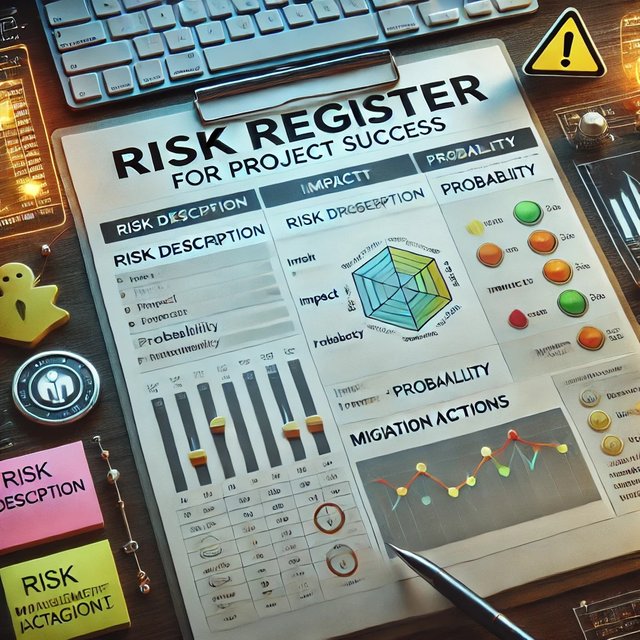Risk Register for Project Success: Templates and Risk Management Tips
Effective risk management is essential for the success of any project. From construction to IT, businesses face a variety of project risks that, if unmanaged, could lead to delays, budget overruns, or project failure. A Risk Register is a powerful tool for capturing, tracking, and mitigating these risks, ensuring that your project stays on course. By identifying risks early and developing a contingency plan, you can prevent unforeseen issues from derailing your progress.

What is Risk Management?
Risk management involves identifying, analyzing, and addressing potential risks that could negatively impact a project. In project management, managing risks is crucial to minimize uncertainties and to plan effectively. A Risk Register serves as a central hub where all potential project risks are recorded, analyzed, and monitored, helping teams manage the uncertainties that can arise throughout the project lifecycle.
Key Risk Categories to Consider
When developing a Risk Register, it’s important to understand the different categories of risks that could affect your project. Here are some key risk categories to consider:
- Safety Risks: Physical dangers, environmental hazards, or potential accidents that could harm workers or infrastructure.
- Operational Risks: Challenges that affect daily operations, such as supply chain disruptions, equipment failure, or resource shortages.
- Reputational Risks: Risks that can impact your company’s brand and public perception, including customer dissatisfaction or PR crises.
- Strategic Risks: External factors like market shifts, new competitors, or changes in regulations that could affect your business strategy.
- Financial Risks: Risks related to budgeting, cash flow, and profitability. These could include unexpected costs, funding issues, or currency fluctuations.
- Compliance Risks: Legal or regulatory risks, such as non-compliance with government regulations or industry standards.
By categorizing risks, you can more effectively target your risk mitigation strategies and ensure that you are prepared for a variety of scenarios.
Why Perform a Risk Analysis?
Performing a risk analysis allows you to assess the likelihood and impact of potential risks, helping you prepare contingency plans and manage stakeholder expectations. Here’s why it’s important:
- Mitigating Risks: A solid risk analysis helps identify which risks need immediate attention and which can be monitored. By assessing risks accurately, you can plan effective risk mitigation strategies.
- Managing Stakeholder Expectations: By clearly presenting potential risks and their impact, you can manage expectations and build confidence with stakeholders.
- Assigning Risk Ownership: Effective risk analysis ensures that each risk is assigned to a responsible owner who will monitor and address it as needed, enhancing accountability within the team.
Types of Risk Analyses
There are two primary types of risk analyses used in project management:
- Quantitative Risk Analysis: This method involves using numerical data to calculate the probability of risks and their potential impact. It’s ideal for more complex projects where precise data is available.
- Qualitative Risk Analysis: This approach is based on general evaluation and categorization of risks by their overall likelihood and potential impact. It’s used when a more flexible, context-based analysis is sufficient.
Both methods are valuable depending on the complexity and needs of the project.
Steps to Creating a Risk Register
Creating an effective Risk Register involves several key steps. Here’s how to build one for your project:
Step 1: Identify Risks
Use risk identification tools such as brainstorming sessions, historical data, or project schedules to identify potential risks. Consider the various risk categories and ensure that no potential threats are overlooked.
Step 2: Analyze Risks
Once risks are identified, use risk analysis methods to prioritize them based on their likelihood and potential impact. This is often done using a risk matrix, which visually ranks risks to help project managers focus on the most critical issues.
Step 3: Develop Action Plans
For each identified risk, create a risk response plan that outlines the strategies to mitigate, transfer, or accept the risk. This includes steps like preventive measures, contingency planning, or establishing fallback options.
Step 4: Prevent Future Risks
As the project progresses, regularly update the Risk Register and monitor potential risks. Assign risk owners to track and address risks, ensuring that all team members are aware of their responsibilities.
By following these steps, you can create a comprehensive Risk Register that helps your team manage and respond to risks efficiently.
How to Use a Risk Register Template
One of the easiest ways to create and maintain a Risk Register is by using a template. Here’s how you can utilize risk register templates to streamline your risk management:
- Excel Templates: Microsoft Excel is a powerful tool for building a risk register, allowing you to organize risks, categorize them, and assign risk owners. It’s highly customizable and can be tailored to your project’s needs.
- Ready-to-Use Templates: Many ready-made risk register templates are available online for different project types, including construction, IT, and business projects. These templates often include built-in categories and risk matrices.
- Customizing Templates: You can modify any template to fit your specific project by adding or removing columns, adjusting risk categories, or incorporating additional data points such as timeframes or budget impacts.
Using a template saves time and ensures consistency in how risks are documented and managed across different projects.
Conclusion
A well-maintained Risk Register is invaluable for ensuring project success. By identifying, analyzing, and addressing risks early, you can keep your project on track and avoid unexpected setbacks. Implementing effective risk management practices, supported by tools like risk register templates, gives your team the foresight needed to navigate complex projects with confidence.
Start incorporating a Risk Register into your project management process today to enhance risk mitigation, improve stakeholder communication, and ensure smoother project execution.
Read also our last article: Work Breakdown Structure: Free Template and Example Guide
Source: https://royalcdkeys.com/blogs/news/risk-register-template-the-risk-identification-tool